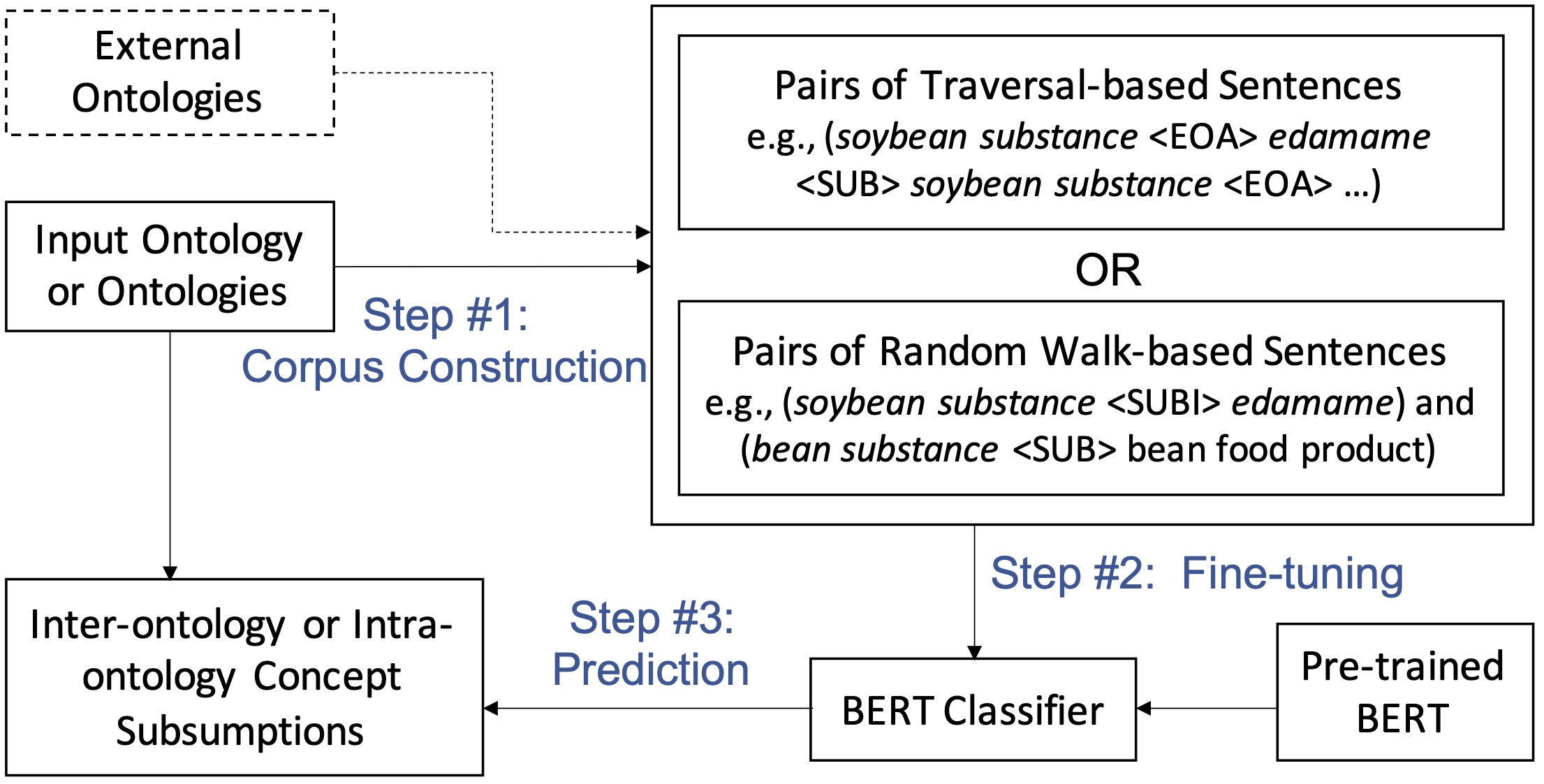Subsumption Prediction with BERTSubs
Citation
@article{chen2023contextual,
title={Contextual semantic embeddings for ontology subsumption prediction},
author={Chen, Jiaoyan and He, Yuan and Geng, Yuxia and Jim{\'e}nez-Ruiz, Ernesto and Dong, Hang and Horrocks, Ian},
journal={World Wide Web},
pages={1--23},
year={2023},
publisher={Springer}
}
This page gives the tutorial for \(\textsf{BERTSubs}\) including the functions, the summary of the models and usage instructions.
The current version of \(\textsf{BERTSubs}\) is able to predict:
- named subsumptions between two named classes, or complex subsumptions between one named class and one complex class, within an ontology,
- named subsumption between two named classes, or complex subsumptions between one named class and one complex class, across two ontologies (note the former corresponds to subsumption mapping).

Figure 1. Pipeline illustration of BERTSubs.
The pipeline of \(\textsf{BERTSubs}\) consists of following steps.
-
Corpus Construction: extracting a set of sentence pairs from positive and negative subsumptions from the target ontology (or ontologies), with one of the following three templates used for transforming each class into a sentence,
- Isolated Class, which just uses the names of the input class,
- Path Context, which uses the names of the upper (resp. down) path starting from the input superclass (resp. subclass),
- Breadth-first Class Context, which uses the names of the input class's surrounding classes.
-
Model Fine-tuning: fine-tuning a language model such as BERT with the above sentence pairs.
- Prediction: using the fine-tuned language model to predict the subsumption scores of the given candidate class pairs.
Note that the optionally given subsumptions via a train subsumption file can also be used for fine-tuning. Please see more technical details in the paper.
Evaluation Case and Dataset (Ontology Completion)
The evaluation is implemented scripts/bertsubs_intra_evaluate.py. Download an ontology (e.g., FoodOn) and run:
python bertsubs_intra_evaluate.py --onto_file ./foodon-merged.0.4.8.owl
The parameter --subsumption_type can be set to 'restriction' for complex class subsumptions, and 'named_class' for named class subsumptions. Please see the programme for more parameters and their meanings.
It executes the following procedure:
-
The named class or complex class subsumption axioms of an ontology is partitioned into a train set, a valid set and a test set. They are saved as train, valid and test files, respectively.
-
The test and the valid subsumption axioms are removed from the original ontology, and a new ontology is saved.
Notice: for a named class test/valid subsumption, a set of negative candidate super classes are extracted from the ground truth super class's neighbourhood. For a complex class test/valid subsumption, a set of negative candidate super classes are randomly extracted from all the complex classes in the ontology.
Usage
To run \(\textsf{BERTSubs}\), a configuration file and one input ontology (or two ontologies) are mandatory. If candidate class pairs are given, a fine-tuned language model and a file with predicted scores of the candidate class pairs in the test file are output; otherwise, only the fine-grained language model is output. The test metrics (MRR and Hits@K) can also be output if the ground truth and a set of negative candidate super classes are given for the subclass of each valid/test subsumption.
-
The following code is for intra-ontology subsumption.
from yacs.config import CfgNode from deeponto.complete.bertsubs import BERTSubsIntraPipeline, DEFAULT_CONFIG_FILE_INTRA from deeponto.utils import load_file from deeponto.onto import Ontology config = CfgNode(load_file(DEFAULT_CONFIG_FILE_INTRA)) # Load default configuration file config.onto_file = './foodon.owl' config.train_subsumption_file = './train_subsumptions.csv' # optional config.valid_subsumption_file = './valid_subsumptions.csv' # optional config.test_subsumption_file = './test_subsumptions.csv' #optional config.test_type = 'evaluation' #'evaluation': calculate metrics with ground truths given in the test_subsumption_file; 'prediction': predict scores for candidate subsumptions given in test_submission_file config.subsumption_type = 'named_class' # 'named_class' or 'restriction' config.prompt.prompt_type = 'isolated' # 'isolated', 'traversal', 'path' (three templates) onto = Ontology(owl_path=config.onto_file) intra_pipeline = BERTSubsIntraPipeline(onto=onto, config=config) -
The following code is for inter-ontology subsumption.
from yacs.config import CfgNode from deeponto.complete.bertsubs import BERTSubsInterPipeline, DEFAULT_CONFIG_FILE_INTER from deeponto.utils import load_file from deeponto.onto import Ontology config = CfgNode(load_file(DEFAULT_CONFIG_FILE_INTER)) # Load default configuration file config.src_onto_file = './helis2foodon/helis_v1.00.owl' config.tgt_onto_file = './helis2foodon/foodon-merged.0.4.8.subs.owl' config.train_subsumption_file = './helis2foodon/train_subsumptions.csv' # optional config.valid_subsumption_file = './helis2foodon/valid_subsumptions.csv' # optional config.test_subsumption_file = './helis2foodon/test_subsumptions.csv' # optional config.test_type = 'evaluation' # 'evaluation', or 'prediction' config.subsumption_type = 'named_class' # 'named_class', or 'restriction' config.prompt.prompt_type = 'path' # 'isolated', 'traversal', 'path' (three templates) src_onto = Ontology(owl_path=config.src_onto_file) tgt_onto = Ontology(owl_path=config.tgt_onto_file) inter_pipeline = BERTSubsInterPipeline(src_onto=src_onto, tgt_onto=tgt_onto, config=config)
For more details on the configuration, please see the comment in the default configuration files default_config_intra.yaml and default_config_inter.yaml.
Created: April 14, 2023

